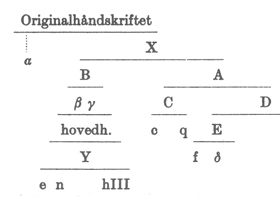Exemplar
An exemplar is a text which has been transcribed in a copy or apograph. The exemplar may have been copied by visual inspection by the copyist or by way of dictation of somebody else (cf. copying of texts - methods).
In the process of manuscript copying, a copy would often become the exemplar of a new copy, which then might become the exemplar of yet another copy, and so on. This kind of copying chain can be described as a directed acyclic graph.
In a stemma, an exemplar is always placed immediately above its copy. In fig. 1, the hyparchetype B was the exemplar for the fragments β and γ, which in turn were exemplars for the main manuscript (“hovedh[åndskriftet]”), which in turn was the exemplar for Y, which finally were copied in e, n and hIII. Note that due to the procedure of eliminatio codicum descriptiorum, many copies are simply removed from the stemma. The example here is a little unusual, and can be explained by the fact that the fragments β and γ are the modest remains of a once complete manuscript. If this had been preserved in a complete state, the copies below would have been removed in the elimination procedure, and this manuscript would have become the main manuscript.

Fig. 1. A stemma for the Old Norwegian Konungs skuggsjá (mid-13th century), from the edition by Ludvig Holm-Olsen (1983, p. xiv).
Cf. also ancestor.
References
– Holm-Olsen, Ludvig, ed. 1983. Konungs skuggsiá. 2nd ed. Norrøne tekster, vol. 1. Oslo: Kjeldeskriftfondet.
– West, Martin L. 1973. Textual Criticism and Editorial Technique Applicable to Greek and Latin Texts. Stuttgart: Teubner. || See p. 12.